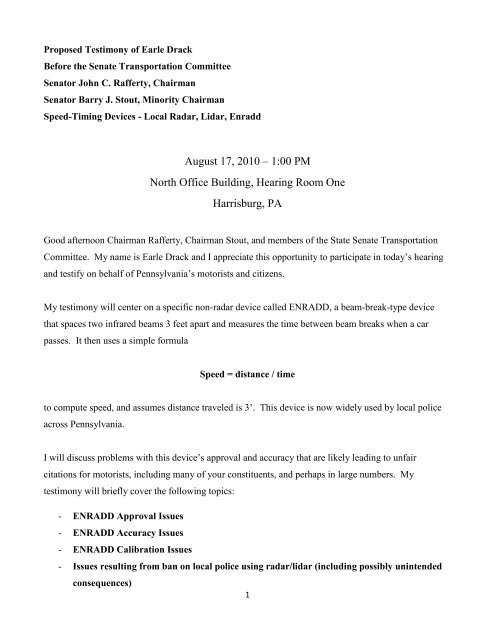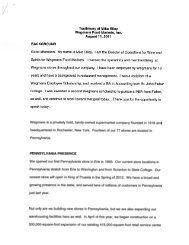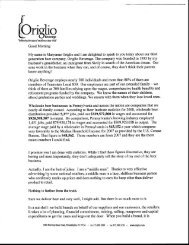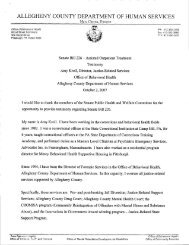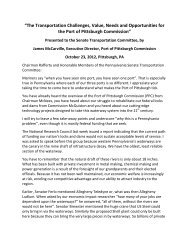August 17, 2010 – 1:00 PM North Office Building, Hearing Room ...
August 17, 2010 – 1:00 PM North Office Building, Hearing Room ...
August 17, 2010 – 1:00 PM North Office Building, Hearing Room ...
- No tags were found...
You also want an ePaper? Increase the reach of your titles
YUMPU automatically turns print PDFs into web optimized ePapers that Google loves.
Proposed Testimony of Earle Drack<br />
Before the Senate Transportation Committee<br />
Senator John C. Rafferty, Chairman<br />
Senator Barry J. Stout, Minority Chairman<br />
Speed-Timing Devices - Local Radar, Lidar, Enradd<br />
<strong>August</strong> <strong>17</strong>, <strong>2010</strong> <strong>–</strong> 1:<strong>00</strong> <strong>PM</strong><br />
<strong>North</strong> <strong>Office</strong> <strong>Building</strong>, <strong>Hearing</strong> <strong>Room</strong> One<br />
Harrisburg, PA<br />
Good afternoon Chairman Rafferty, Chairman Stout, and members of the State Senate Transportation<br />
Committee. My name is Earle Drack and I appreciate this opportunity to participate in today’s hearing<br />
and testify on behalf of Pennsylvania’s motorists and citizens.<br />
My testimony will center on a specific non-radar device called ENRADD, a beam-break-type device<br />
that spaces two infrared beams 3 feet apart and measures the time between beam breaks when a car<br />
passes. It then uses a simple formula<br />
Speed = distance / time<br />
to compute speed, and assumes distance traveled is 3’. This device is now widely used by local police<br />
across Pennsylvania.<br />
I will discuss problems with this device’s approval and accuracy that are likely leading to unfair<br />
citations for motorists, including many of your constituents, and perhaps in large numbers. My<br />
testimony will briefly cover the following topics:<br />
- ENRADD Approval Issues<br />
- ENRADD Accuracy Issues<br />
- ENRADD Calibration Issues<br />
- Issues resulting from ban on local police using radar/lidar (including possibly unintended<br />
consequences)<br />
1
Background<br />
Drack Testimony <strong>–</strong> <strong>August</strong> <strong>17</strong>, <strong>2010</strong><br />
I believe I am qualified to testify on these matters in that I not only received an ENRADD citation which<br />
I believe to have been in error by more than 16 mph, but I am also an engineer and engineering manager<br />
with over 25 years experience in the design and test of precision measurement instrumentation,<br />
primarily for the petroleum industry. My education includes a master’s degree in Electrical Engineering<br />
from Cornell University and an MBA from the Wharton School of Business.<br />
I have no outstanding ENRADD citations, having been found not guilty in court, and do not offer any<br />
competing products, and am here simply to see that all Pennsylvanians and visitors to our state are<br />
treated fairly. It was my own citation and my concern as to how an approved device could have given<br />
such a large error that got me looking into this matter, and the more I learned the more I felt compelled<br />
to get these problems addressed so others could avoid an unfair citation and all the associated hassle and<br />
financial penalties. In particular, those motorists who drive for a living and must maintain a clean<br />
driving record are most vulnerable to grossly unfair outcomes.<br />
ENRADD Approval Issues:<br />
As you may be aware, all non-radar devices must be approved by PennDOT before they can be used as<br />
the basis for a citation, and PennDOT has a written procedure for such approval (see attached Figure 1<br />
for the procedure in place at the time the wireless ENRADD EJU-91 was approved in <strong>August</strong> of 2<strong>00</strong>3).<br />
When I first was able to see this procedure the problem was clear <strong>–</strong> instead of PennDOT performing its<br />
own critical and objective technical analysis and testing of a device, they allow the device manufacturer<br />
to specify what testing is (and is not) done. While PennDOT does choose an independent lab to perform<br />
the testing, that lab does only what testing the manufacturer tells it to do. And while PennDOT is<br />
required by its own written approval process to review the testing that was done and issue an<br />
approval/denial report, in this case that step was not performed, and it is not clear whether PennDOT<br />
even has someone qualified to do such a technical review and analysis. What’s more, PennDOT says it<br />
has no record of a written instruction that the wireless ENRADD be included in the PA Bulletin list of<br />
approved devices. It is therefore unclear, even now, on what basis and on whose authority the<br />
wireless ENRADD EJU-91 was approved and how it came to show up on that list.<br />
2
Drack Testimony <strong>–</strong> <strong>August</strong> <strong>17</strong>, <strong>2010</strong><br />
In the case of the wireless ENRADD EJU-91, only laboratory tests were specified by the manufacturer,<br />
and those tests could not (and thus did not) reveal certain significant design flaws. Let me reiterate that;<br />
based on the information I was provided under the Open Records law, the wireless ENRADD EJU-91<br />
was never even road tested prior to approval!<br />
Please note that this approval is very significant, because in Pennsylvania if a device is approved and has<br />
been calibrated in accordance with the PA Code, that is prima facie evidence of accuracy and the burden<br />
of proof shifts to the defendant. So while it may be tempting to say, “Well, no device is perfect, that’s<br />
why you are allowed to challenge it in court”, I’d like to respectfully point out that as a practical matter<br />
only folks with a technical background and the stubbornness to track down information which is not<br />
easily available have any chance to successfully challenge an ENRADD citation. It is much more likely<br />
that people will just plead guilty or will show up in court unprepared and be found guilty.<br />
I’d like to take a moment to contrast PennDOT’s non-radar device approval with the approval process<br />
for radar and lidar devices. Those devices must be checked out by the State Police and must also be of a<br />
type approved by the International Association of Chiefs of Police (IACP), which works closely with the<br />
NHTSA and the <strong>Office</strong> of Law Enforcement Services at the National Institute of Standards and<br />
Technology (OLES at NIST). The OLES is staffed by many scientists and engineers and thus has the<br />
proper experience and skill sets to perform such analysis and testing. In fact, the OLES, NHTSA, and<br />
IACP promulgate very detailed technical specifications for radar and lidar devices, stating, “NHTSA<br />
also believes that these performance specifications and testing protocols will increase the confidence<br />
of law enforcement officers, the public and the courts in the accuracy and reliability of this<br />
equipment”. Such confidence is important for non-radar devices as well.<br />
ENRADD Accuracy Issues<br />
There are several obvious accuracy issues with the ENRADD device, and I would be happy to discuss<br />
them all off line. In the interest of brevity I will simply focus now on one such issue.<br />
For a beam-break device like ENRADD, the accuracy is dependent on the distance traveled between the<br />
beam breaks to be known accurately. In the case of ENRADD, that distance is assumed to be 3’ since<br />
that is the beam separation on the roadside set by the mechanical support.<br />
3
Drack Testimony <strong>–</strong> <strong>August</strong> <strong>17</strong>, <strong>2010</strong><br />
It is easy to see however, that if beams are triggered by two different points on the car, say by the tires<br />
for the start beam and the bumper for the stop beam, then the distance traveled is not 3’ but less,<br />
resulting in an artificially high speed reading. See below:<br />
Also, it has been implied that a test-drive of the police vehicle through the ENRADD is a good way to<br />
ensure proper alignment and thus avoid bad tickets. Note, however, that if the beams are set to a height<br />
that corresponds to the center of the police vehicle bumper, the device could read correctly for that<br />
vehicle even if there are several inches of height difference between beams.<br />
4
Drack Testimony <strong>–</strong> <strong>August</strong> <strong>17</strong>, <strong>2010</strong><br />
See diagram below, in which the reading will be correct for the police vehicle but may have large errors<br />
for vehicles with different bumper heights/profiles like SUV’s or pickups.<br />
Also, even if it were possible to align the beams at the exact same height with respect to the roadway<br />
(for all points on the roadway), similar errors could still result from any bounce, road unevenness, or<br />
other slight changes to vehicle height between the start and stop beams such as a slight dip in the front if<br />
brakes are applied. What’s more, all roads are designed with a “crown” for water runoff, so a straight<br />
infrared beam will be at many different heights depending where on the road surface you measure.<br />
The manufacturer is aware of this problem, going so far as to tell officers via the training manual to<br />
“avoid triggering in the middle range…because you may trigger off different points on the car” (see<br />
attached Figure 2). The problem, of course, is that what is “middle range” for one vehicle is not “middle<br />
range” for another. For example, a video link at the manufacturer’s website shows an officer stating he<br />
sets the beam at about 14” to place them at mid-bumper. As can be seen in the following photos,<br />
however, 14” is near the lower bumper edge, right where it is most likely to cause error, for two<br />
different SUV’s.<br />
5
Drack Testimony <strong>–</strong> <strong>August</strong> <strong>17</strong>, <strong>2010</strong><br />
Roads are not flat like laboratory floors, and a thorough road test regimen would likely have caught this<br />
design problem in the approval process.<br />
This is not just my theory; it was recently reported on in a WTAE Team 4 Investigative Report aired on<br />
local Pittsburgh television (http://www.thepittsburghchannel.com/news/22910814/detail.html ), and the<br />
expert they consulted agreed with this analysis.<br />
Similarly, I have explained this issue to a number of local police officers, including several Chiefs of<br />
Police, and have been told this makes sense and that I should meet with the manufacturer to help them<br />
address it. One chief even offered to set up such a meeting. In fact, despite the hassles associated with<br />
my ticket I found my interactions with local police to be a very positive takeaway from all this. I am<br />
convinced that local police are interested in fairness, and that they assumed (as most people did) that the<br />
device was accurate based on its approval by PennDOT. I am pro law enforcement but believe it should<br />
be based on accurate technology. It should also be noted that since the error could be on the low side as<br />
well, some speeders are not being cited by virtue of the accuracy problems with ENRADD.<br />
6
ENRADD Calibration Issues<br />
Drack Testimony <strong>–</strong> <strong>August</strong> <strong>17</strong>, <strong>2010</strong><br />
As stated earlier, the wireless ENRADD EJU-91 uses 3’ beam spacing and has used this spacing since<br />
2<strong>00</strong>3. The PA Code, however, is very clear that all ENRADD EJU-91 devices must be calibrated<br />
assuming a 5’ spacing (see attached Fig. 3). If the calibrations currently being done assume a 3’<br />
spacing, then this violation of the PA Code would presumably invalidate all such ENRADD calibrations<br />
and render the citations on which they were based invalid. It is not clear why this provision of the PA<br />
Code is being ignored, especially since a 5’ spacing would make the device less sensitive to the type<br />
of error described earlier.<br />
Issues resulting from ban on local police using radar/lidar<br />
The current situation in Pennsylvania, with local police unable to use radar, has some interesting<br />
consequences. First, it creates a market for devices which will only be used in PA since they are more<br />
expensive, less accurate, and harder to use than radar. The total yearly demand for such units may be as<br />
low as a few tens of devices per year compared to many thousands per year for radar and lidar. Thus,<br />
while the volume of radar and lidar allows for economies of scale and can support an expensive R&D<br />
and Quality Control effort, such economies of scale are smaller or absent for non-radar devices.<br />
Similarly, the need to have a separate approval process for non-radar devices, of which there are<br />
relatively few, means that PennDOT may not utilize the process for several years running, so the<br />
required technical expertise and understanding of the issues may not be available when needed,<br />
Recommendation<br />
Based on the foregoing, I respectfully recommend that this committee, in its oversight role for<br />
PennDOT, see that the wireless ENRADD EJU-91 approval is suspended immediately pending a<br />
thorough evaluation of the problems with the device. Note that even if radar is eventually allowed for<br />
local police, the immediate suspension of the ENRADD approval is necessary to stop unfair citations<br />
from being written.<br />
Thank you.<br />
7
Drack Testimony <strong>–</strong> <strong>August</strong> <strong>17</strong>, <strong>2010</strong><br />
Figure 1<br />
8
Drack Testimony <strong>–</strong> <strong>August</strong> <strong>17</strong>, <strong>2010</strong><br />
Figure 2<br />
Figure 3<br />
9


